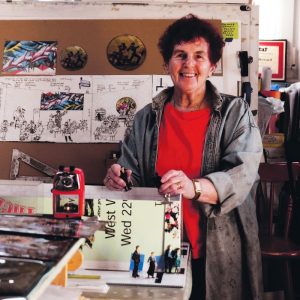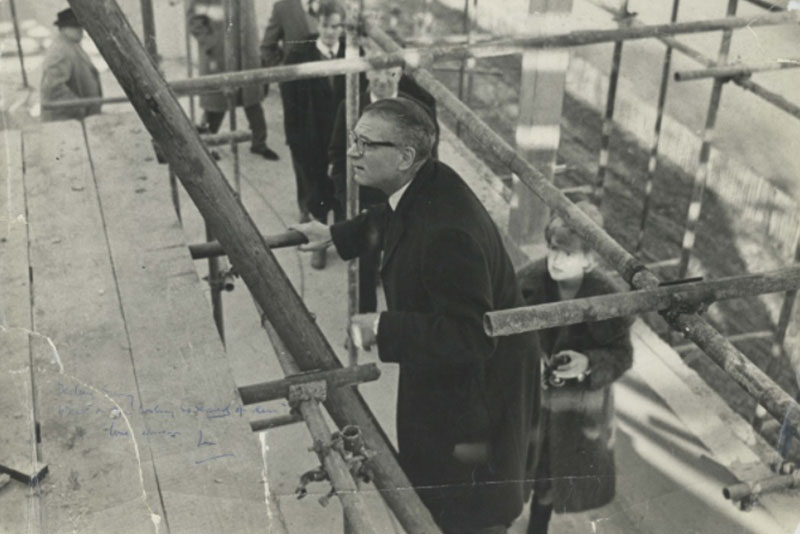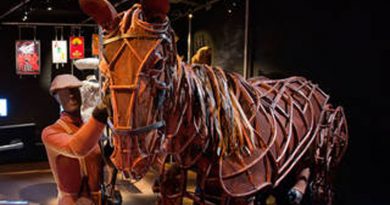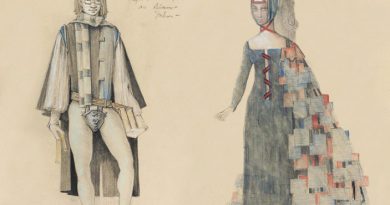Pamela Howard: Theatre designer
Jeremy Malies makes regular visits returns to Chichester in West Sussex for this magazine. This time he visits the Pallant House Gallery where Professor Pamela Howard is his guide to “The Art of Chichester Festival Theatre: A Celebration.”
Pamela Howard is one of the pre-eminent theatre designers in the UK and an international figure who has collaborated with major directors at theatres worldwide. But she was set a stern challenge when Stefan van Raay, director of the Pallant House Gallery, asked her to produce a retrospective exhibition on the first 25 years at the Chichester Festival Theatre. She recalls: Stefan came to my studio and said that he liked my own work. He wanted to do something for the fiftieth anniversary that would be different and serve as a retrospective. Above all, if I took the commission I should not forget that this is a theatre complex that has been built into a park.”

Any visitor to the exhibition would be struck by one of the first pieces in the display, a painting of the theatre at night during the inaugural season by Raymond Myerscough–Walker (1908-1984). The canvas deserves a prominent position since its creator was a bohemian local who spent many years living in woods near Chichester in a rented cottage, a caravan and even a tent. He immediately establishes the sylvan theme which my host reinforces as she stoops to dust down and tenderly reposition a stuffed toy which is either a hare or a large rabbit. Its habitat is a stretch of AstroTurf which has just been visited by rampaging toddlers.
The exhibition is proving popular and Pamela takes obvious pride in the flow of visitors. She describes how as a young woman she was part of the inaugural Chichester season in 1962, being employed to make headdresses for The Chances and for Olivier’s equally eccentric choice, The Broken Heart, a Caroline Era tragedy which John Ford, for reasons best known to himself, chose to set in classical Sparta. Pamela’s summary is: “It was new, exciting and exactly the place I wanted to be.”
My attention is caught by a model of Carl Toms’s design for a 1970 production of The Alchemist. “We found the exhibits in some unlikely places after putting an appeal out. Jill Evershed-Martin [wife of festival founder, Leslie] said she had a shoebox containing some brown pieces of wood and didn’t know what they were. I knew what they were alright and managed to assemble them.”
Toms (1927-1999) was a frequent collaborator with Tom Stoppard. Pamela stresses how the model for the Jonson play exploits diagonal space. From wherever I look at the set, I get a clear view of the central character’s fraudulent schemes, and Pamela reinforces this thought: “Instructions come straight from the board members with your contract at Chichester stressing that this is a democratic space. Everybody must have a comparable experience. There are no ‘best’ or ‘worst’ seats.”

Sir Laurence Olivier at topping-out ceremony. Photo courtesy of CFT and West Sussex Archive Office.
The models, drawings and paintings are laid out in such a way that the viewer is confronted with contrasting use of space by scenographers. From the diagonal, we progress to the vertical and my favourite item in the exhibition, Stefano Lazaridis’s model of the musical The Mitford Girls, a Caryl Brahms, Ned Sherrin and Peter Greenwell collaboration which died a death on a London run at the Globe (now the Gielgud Theatre) in 1981 but was greeted favourably at Chichester later the same year.
Even this piece, which is about two feet high, conveys the sense that the set must have towered above the audience and constantly raised their focal point upwards and away from the false perspective of a white hexagonal stage floor to a cascading staircase and a gallery. A lone Mitford sister has just made her entry in the manner of a Hollywood musical ‘walkdown’ and I nurse a hope that it is my heroine ‘Decca’.
In the centenary year of the events depicted, a model that demands attention is the set of Ted Tally’s play Terra Nova which deals with Scott’s doomed expedition to the South Pole in 1912. Tally gained fame with his screenplay for The Silence of the Lambs but should be celebrated for this piece which was designed by Pamela herself for a Chichester production in 1980. After the linear nature of the previous exhibits, Pamela describes this as the ‘soft’ approach as well as a cheap and environmentally-friendly one. Having coated the stage with white powder and draped gauze on the set to represent glaciers and ice floes, she used packing cases and timber from a flood-damaged warehouse for Scott’s sledge.
I resist an urge to pick up the doll representing Captain Oates, march him away and announce to the crowd that has gathered around Pamela and I that he is “just going outside and may be some time” Pamela takes it as one of the prettiest compliments ever paid to her that despite the run taking place in a heat wave, the Pimm’s and champagne bars were neglected at every performance as audiences shivered and clamoured for hot drinks during the interval. Her design and the lighting stressed the cinematic quality of Tally’s text, with characters coming in and out of focus around Scott (played by Hywel Bennett). Over 30 years her relish for the final coup de théâtre remains: “King George V had demanded a photo at the pole whatever the outcome. As the flash went off around the defeated expedition we had a ghostly Amundsen slip into the picture.”

Model for The Mitford Girls. Photo courtesy of CFT.
“When did I ever see anything as daring?” is Pamela’s question as we reach the next exhibit and the “sculptural approach” of Ralph Koltai (b 1924) who in 1968 made Prospero’s island a billow of black silk. “Ralph called it an island of the mind” she continues. The minimalist set approaches a geometrical abstraction dominated by orbs and discs, one of which moved to expose Caliban’s cell. The whole stage is a shallow bowl, and a set of nested globes allowed situations to be revealed including the discovery of Ferdinand and Miranda playing chess.
We move to a gleaming display with a complicated history. The miniature set is the work of opera and theatre designer Peter Rice and was used in 1967 for the almost balletic farce An Italian Straw Hat. Pamela recalls: “The piece was supposed to be A Servant of Two Masters with Danny Kaye in the lead. We were at an early stage, with Kaye having trouble remembering his lines, when the Six-Day War broke out. Kaye left immediately saying he was going to ‘help solve the war problem’ and he never returned. The production couldn’t find a replacement and the budget had gone. So we switched to a farce and Peter simply painted everything white.” The anecdote closes with a derisive snort which I take as questioning just exactly how Danny Kaye thought he could mediate between Nasser and Moshe Dayan.
Only one exhibit represents a giant in the field, Sean Kenny (1929-1973), who was responsible for the set of Uncle Vanya in Chichester’s inaugural 1962 season. Pamela recalls: “I’d despaired of finding anything from the production when I happened to visit Alec McCowen. I thought I knew everything on the walls of his flat but noticed something new. Alec said: ‘Oh, yes. Just bought it at auction. Something to do with Chichester I think.’” The piece is a bold sketch of how Kenny envisaged Uncle Vanya drawn with an innovative tool, the recently-introduced felt pen.
Pamela is keen to show me her own representation of Chichester’s famed parkland setting and a life-size golden oak tree occupied by the Roman owl belong to Minerva, namesake of the studio theatre space here. She insists that I inspect the lustrous wickerwork bird from all angles, perhaps reinforcing the credo in these theatres that every vantage point should be revealing.
This part of the Pallant House Gallery could serve as the forest in As You Like It, and an audio loop combines birdsong with recordings of previous Chichester artistic directors including Olivier and Patrick Garland. The tree is bedecked with multi-coloured ribbons containing critical opinions from the opening season in 1962. They range from: “The thrust is a must” (anon) to “Pity about the sound” (Daily Telegraph) and “This is no place for Chekhov.” (Daily News.) The audio exhibit is the work of sound designer Tom Lishman with whom Pamela collaborated recently as scenographer on The Great Game at the Tricycle Theatre in Kilburn, London.
The reminiscences stretch over 50 years but could not be more apposite or evocative. Pamela turns to the costume she made for Alec Guinness as Shylock in 1984. “It belongs to the V & A and I had not seen it since the season we did the play. I started telling Alec that I had used the edge of an old sari and explaining what my thoughts were about progressing the costume. I was pulled up short. ‘Dear girl. Just give me a very narrow doorway and a coat I can trail behind me. I’ve always had success with trailing.’ From the moment of: ‘What news on the Rialto?’ he had the audience in the palm of his hand. While I was trying to explain context he went to the heart of the social situation. It was a good lesson to learn.”
Having covered one major figure in Sean Kenny, we turn to another , Jocelyn Herbert (1917-2003). “She was a great mentor and I miss her a lot. I first met her in 1958 when she did the Wesker Trilogy at the Belgrade Theatre, Coventry. Joycelyn had been to Berlin and worked with Brecht. At the time I was a young scene painter based at the Birmingham Rep. That season at Birmingham was interesting. In those days the principal actors didn’t talk to junior staff like me. But there was one actor who made a point of talking to us. He also swore a lot and wore something we had never seen before – jeans. He said that if the M1 motorway project ever got finished he would drive a group of us to Coventry. We finally visited Coventry and I was introduced to Joycelyn. The young actor’s name? Oh … that was Albert Finney.”
Pamela shows me her set design for the 1984 production of The Merchant of Venice starring Guinness and the penny finally drops as to one of her own influences. The ghetto wall features extensive text about curfews and rules. This is her equivalent of the Brechtian trademark placard. She explains that the thrust stage at Chichester based on a prototype at Stratford, Ontario, put an end to the laziness reflected in platitudes such as: “That won’t notice when it’s lit” or “Nobody will see the rear of the costume.” She stresses that if she has learnt one lesson it is the importance of props on an open stage.
I ask if there is a specific secret to working at Chichester. “Yes. I always quote Findlay James, my teacher at the Birmingham College of Art. He used to say: ‘If you ever go to work at Chichester, remember that the detail is at the back.’” By now we have returned to the entrance to the exhibition and are inspecting a model of the very area we are in. Pamela explains that children are allowed to pick it up and explore the notion of space. She recalls her own childhood. “When I discovered theatre, I already knew that I loved drawing. I realised that as a theatre designer I would be able to follow all the things I was interested in, like history and politics, and reflect these in my work. That was enough.”
Pamela Howard’s Book “What is Scenography?” is available in hardback, paperback and as an e-book. It can be bought from the publisher, Routledge, or from Amazon.









